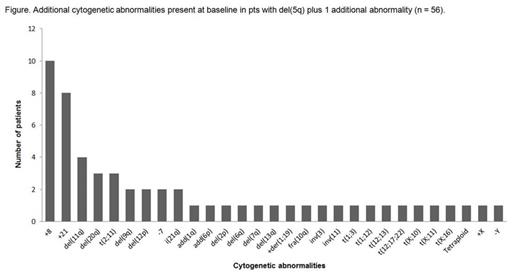Abstract
Introduction: Around 50% of pts with de novo MDS present with chromosomal abnormalities at diagnosis. One of the most common cytogenetic abnormalities in MDS, deletion 5q [del(5q)], occurs in ~15% of pts (Haase et al. Blood 2007;110:4385-95). The presence of cytogenetic abnormalities in addition to del(5q) may be associated with shorter overall survival (OS) and increased risk of progression to acute myeloid leukemia (AML) versus del(5q) alone (Mallo et al. Leukemia 2011;25:110-20). In 2 large multicenter studies (MDS-003 and MDS-004), lenalidomide (LEN) was evaluated in RBC transfusion-dependent pts with IPSS Low/Intermediate (Int)-1-risk MDS and del(5q) (List et al. N Engl J Med 2006;355:1456-65; Fenaux et al. Blood 2011;118:3765-76). This analysis describes the prevalence and clinical impact of the most common cytogenetic abnormalities in pts with del(5q) from MDS-003 and MDS-004.
Methods: Of 353 pts enrolled in MDS-003 and MDS-004, 281 pts had available cytogenetic data with ≥ 16 metaphases evaluable, and were included in the analysis. Pts received 10 mg LEN on days 1–21 of each 28-day cycle; LEN 5 mg or 10 mg continuously; or placebo. In MDS-004, placebo pts could crossover to LEN 5 mg by Week (Wk) 16. Centrally reviewed cytogenetic studies were performed at baseline, and wks 24 and 48 (MDS-003); or baseline, Wk 24, and every 24 wks thereafter (MDS-004). RBC-transfusion independence (RBC-TI) ≥ 26 wks, cytogenetic response (CyR), AML progression, and OS were assessed by most common cytogenetic abnormalities in LEN-treated pts with del(5q) plus 1 additional abnormality. Some pts did not fulfill the IPSS lower-risk classification after central pathologic/cytogenetic evaluation. For this analysis outcomes in the del(5q) plus ≥ 2 additional abnormalities group were not evaluated.
Results: Of the 281 pts, 70.8% had isolated del(5q), 19.9% del(5q) plus 1 additional abnormality, and 9.3% had del(5q) plus ≥ 2 additional abnormalities. Baseline characteristics including age, time from diagnosis, RBC transfusion burden, hemoglobin level, and platelet and absolute neutrophil counts were comparable across the cytogenetic groups. In pts with del(5q) plus 1 additional abnormality at baseline, the most common numerical abnormalities were +8 (17.9%; n = 10), +21 (14.3%; n = 8), and −7 (3.6%; n = 2); the most common balanced structural rearrangements were translocation 2;11 [t(2;11)] (5.4%; n = 3) and isochromosome 21q [i(21q)] (3.6%; n = 2); and the most common unbalanced structural rearrangements were del(11q) (7.1%; n = 4), del(20q) (5.4%; n = 3), del(9q) (3.6%; n = 2), and del(12p) (3.6%; n = 2) (Figure). In the del(5q) plus 1 additional abnormality group, baseline characteristics were comparable across pts with +8, +21, or other abnormalities (i.e. excluding those with +21 and +8), with the exception of age (P = 0.023). Rates of RBC-TI ≥ 26 wks and CyR did not significantly differ among LEN-treated pts with +8 (n = 9), +21 (n = 8), or other abnormalities (n = 37). Rates of RBC-TI ≥ 26 wks were 66.7%, 50.0%, and 54.1% (P = 0.839), respectively. In pts evaluable for CyR (n = 40), CyR rates were 42.9%, 42.9%, and 65.4% (P = 0.407), respectively. Median time to AML progression was shorter in LEN-treated pts with +21 (2.6 years [yrs]; 95% CI 1.2–4.8) versus +8 (4.8 yrs; 95% CI 1.6–not estimable) or other abnormalities (7.5 yrs; 95% CI 4.1–7.5) (P = 0.0143). The 5-year AML progression rates were 68.8% (95% CI 26.6–98.7), 85.7% (95% CI 53.5–99.3), and 36.3% (95% CI 19.2–61.3) in pts with +8, +21, or other abnormalities, respectively. Median OS was 4.1 yrs (95% CI 0.9–5.3), 3.0 yrs (95% CI 1.1–4.9), and 3.4 yrs (95% CI 2.6–6.5) (P = 0.423), respectively. Of the 2 pts with −7: 1 pt with Int-1-risk MDS had a 92% to 8% reduction of −7-positive metaphases at Day 84 on treatment, but no RBC-TI ≥ 26 wks, and died at Day 709 without AML; the other Int-2-risk pt progressed to AML on Day 147 with clearance of −7 from 8%, and development of new +8 and del(16q) abnormalities.
Conclusions:In MDS pts with del(5q) plus 1 additional abnormality from MDS-003 and MDS-004, the most common cytogenetic abnormalities were +8, +21, del(11q), del(20q), and t(2;11), which accounted for 50% of the additional abnormalities at baseline. In the del(5q) plus 1 additional abnormality population, median time to AML progression was shorter in pts with +21 versus either +8 or other abnormalities. Due to small pt numbers, larger prospective analyses are needed to confirm these observations.
Giagounidis:Celgene Corporation: Consultancy, Honoraria, Membership on an entity's Board of Directors or advisory committees. List:Celgene Corporation: Consultancy. Hellstrom-Lindberg:Celgene: Research Funding. Mufti:Celgene Corporation: Honoraria, Membership on an entity's Board of Directors or advisory committees, Research Funding. Schlegelberger:Celgene Corporation: Consultancy. Morrill:Celgene Corporation: Employment, Equity Ownership. Wu:Celgene Corporation: Employment, Equity Ownership. Skikne:Celgene: Employment, Equity Ownership. Fenaux:Novartis: Research Funding; Janssen: Research Funding; Celgene Corporation: Research Funding.
Author notes
Asterisk with author names denotes non-ASH members.


This feature is available to Subscribers Only
Sign In or Create an Account Close Modal